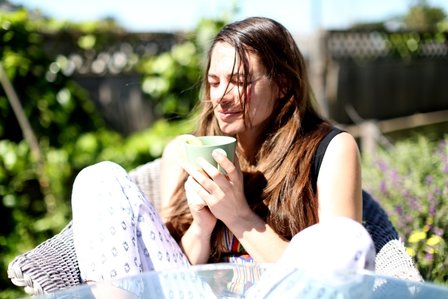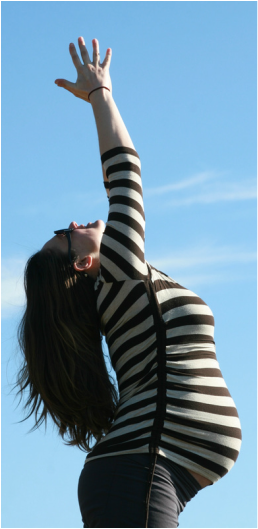|
Be a witness of your current situation. Your job in this practice is to be awake to the moment and every moment as it unfolds. You do not need to try to change it, or make it better, you do not need to like it. Witness all your sensation and emotion - the joy, the anger, the intensity, the dark, the light. See it all. Accept it all. Welcome it all. This is the work that leads to liberation from the things that dilute your potential for unconditional JOY.
 Originally published on the Blog over at yogatreesf.com, April 2016. The conversations around self-care often feel like we are talking about pampering. However, it is much deeper and much more important than that. In fact we are all practicing self-care in one form or another everyday. When we feed ourselves, bathe, sleep or exercise, we are caring for ourselves. Often this caring for ourselves is carried out in an unconscious way. In yoga, meditation and mindfulness a lot of the work is inviting the unconscious into the conscious. Shedding this light on our habits allows us to recognize where there is potential for greater benefit. Combining mindfulness and self-care in an effortless way brings about a revolutionary way to see how you care for yourself. This is important work. As we care for ourselves we are setting ourselves up to be more powerful, peaceful, and active in serving others and making all lives better. Begin by paying attention to a few key needs:
Think about creating rituals around what is important to you. Other needs may involve movement (yoga, dance, exercise), time to yourself, time with friends, touch from others, and mental stimulation. Sometimes take it all a step further, go ahead and pamper.
Here are a few things that you can do while waiting for yoga class to begin:
1. meditate. don't get too concerned with whether or not you are doing it right... just close your eyes in a tall seat and observe your breath. 2. meet someone new. just turn to the nearest person... they will probably sense you looking at them and look back. smile big, like they are already your best friend. say, "hi, my name is ....." and stick out your hand for a shake. this builds community in your studio. this develops your compassion your presence and your connection to others. 3. neck stretches. turn to the left, turn to the right. tip to the left. tip to the right. turn to the left again and nod slowly, up and down. turn to the right and nod slowly. pausing in each position for 1-3 breaths. don't be in any hurry with this. get fascinated by sensation, strong or subtle. 4. go say "hi" to the teacher. i can't speak for every teacher, but i am here for you and i love it when you come to talk with me. when you come tell me your name, check in, and say hi... i am more likely to remember you later and connect with you in that class. come tell me your favorite yoga pose, or one that you are struggling with. let me know where you might want my eye in class. put in a request for a body part or pose you want addressed this class. 5. toe gymnastics. this simple self care act, a lot like a massage, may improve your balance and stability. I learned this from one of my teachers, Harvey Deutch and he has a great description here: http://www.redhawkpt.com/sites/default/files/Toe_Gymnastics.pdf 6. supta padangusthasana. a teacher one told me that this is one of the best things you can do for your body: grab a strap. lay on your back, knees bent, shoulders on floor. loop strap around right foot. lengthen both legs out. lifted leg need not be perpendicular to the floor. one hand on each end of the strap. shoulders get heavy and relaxed. breathe. both ends of the strap move to the right hand, left hand to left thigh or hip. with out lifting the left side of the sacrum, lower right leg to the right. breathe here. bring it back to center. switch hands: straps to left hand, right hand to right hip bone. with out letting the right side of the sacrum lift lower the leg to the left. it will not go far that is OK! breathe here. do it all on your left. I have just completed a year long, 100 hour training focused on yoga therapeutics. There are many varying definitions of this practice. Let me share my definition with you:
Therapeutic Yoga is an offering of breath, movement, and awareness with the intent to heal, transform, maintain, and rejuvenate the body to be the most functional it can be. Therapeutic yoga teachers are aware that everybody is different so while there is deep interest in alignment it is not to get the body to look a certain shape; it is to offer a shape to the body that allows energy, healing, strengthening, lengthening, and release to occur. These changes occur physically, mentally and emotionally. Students of therapeutic yoga are encouraged to let the body and breath be the guide, deepening the wisdom of the body to communicate what is healing and what is hurting. Therapeutic yoga is for anyone with a body, and injured body, a young body, a old body, an imperfect body. Anyone whose body has tightness, hypermobility, flexibility or strength. For anyone who is curious about a whole mind/body practice that encourages overall health. I am not teaching any classes specifically in this style, but I have been incorporating it is to my regular classes. This practice is for anyone who is interested in quality of movement facilitating a lifetime of physical expression in your body.
The endocrine system is a collection of glands that release or inhibit hormones into the circulatory system. These hormones regulate many functions in the body including temperature, hunger, thirst, metabolic rate, attachment, sleep, circadian rhythms, childbirth, emotions and growth. We can use our yoga practice to give each organ a squeeze and stimulate blood and energy flow to improve function of these glands and organs. The following practice is well rounded, and an excellent way to give your entire endocrine system a boost toward optimal function. Please skip any pose that is not appropriate for you. Start in Sukhasana. (Easy crossed legs.) Root sit bones, long spine, lift heart and back of head. Jalandhara bandha. Pranayama. Deep inhale, Long, slow exhale. x10 Visualize the intricate network of systems that make up the body. The respiratory, the circulatory, the endocrine, the nervous systems. See them all humming with energy and life. See them working well to keep you healthy and strong. Cat/Cow. x3-5 Traditional Childs (with forehead making contact on to floor or block). 5 deep breaths Rabbit Pose. 5 breaths Headstand. 3-10 breaths Balasana. (Extended Childs.) Side to side. 3-5 breaths Adho Mukha Svanasana. (Downward Dog.) 5 breaths Uttanasana. (Standing Forward Fold.) 3 breaths Ardha Uttanasana. (Half way Standing forward fold.) 3 breaths Tadasana. (Mountain) Reach up look up, open front body. Vrksasana. (Tree.) 3-5 breaths each side Utthita Trikonasana. (Triangle.) 3-5 breaths each side Ardha chandrasana. (Half Moon.) 3-5 breaths each side Setu bandhasana. 3-10 breaths Open book twists. Halasana. (Plow.) Shoulderstand. Matsyasana. (Fish.) Janu sirsasana. 3 breaths each side Paschimottanasana. 5 breaths Matsyendrasana D. 3 breaths each side Savasana or Supta Baddha Konasana (with bolster supporting back). 3-5minutes
|









 RSS Feed
RSS Feed